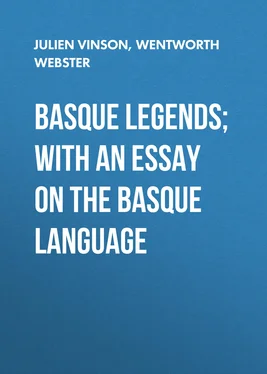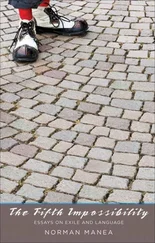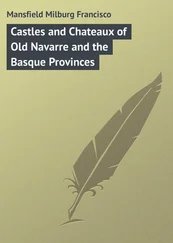Julien Vinson - Basque Legends; With an Essay on the Basque Language
Здесь есть возможность читать онлайн «Julien Vinson - Basque Legends; With an Essay on the Basque Language» — ознакомительный отрывок электронной книги совершенно бесплатно, а после прочтения отрывка купить полную версию. В некоторых случаях можно слушать аудио, скачать через торрент в формате fb2 и присутствует краткое содержание. Жанр: foreign_antique, Старинная литература, Мифы. Легенды. Эпос, на английском языке. Описание произведения, (предисловие) а так же отзывы посетителей доступны на портале библиотеки ЛибКат.
- Название:Basque Legends; With an Essay on the Basque Language
- Автор:
- Жанр:
- Год:неизвестен
- ISBN:нет данных
- Рейтинг книги:3 / 5. Голосов: 1
-
Избранное:Добавить в избранное
- Отзывы:
-
Ваша оценка:
- 60
- 1
- 2
- 3
- 4
- 5
Basque Legends; With an Essay on the Basque Language: краткое содержание, описание и аннотация
Предлагаем к чтению аннотацию, описание, краткое содержание или предисловие (зависит от того, что написал сам автор книги «Basque Legends; With an Essay on the Basque Language»). Если вы не нашли необходимую информацию о книге — напишите в комментариях, мы постараемся отыскать её.
Basque Legends; With an Essay on the Basque Language — читать онлайн ознакомительный отрывок
Ниже представлен текст книги, разбитый по страницам. Система сохранения места последней прочитанной страницы, позволяет с удобством читать онлайн бесплатно книгу «Basque Legends; With an Essay on the Basque Language», без необходимости каждый раз заново искать на чём Вы остановились. Поставьте закладку, и сможете в любой момент перейти на страницу, на которой закончили чтение.
Интервал:
Закладка:
The little dog said to them, “Not a bit like you, you horrible blubber-lips, as you are. You shall see her—yes.”
When the young kings heard that, they were ready to run their swords through the poor little dog. When she gets to Pretty-Rose’s house she hides herself, and tells her all that has happened. Pretty-Rose gives her some good liqueur to drink, and she comes to herself. The king makes a proclamation that whoever shall (merely) spit where the little dog shall have placed her feet shall be killed, and to mind and pay attention to it.
When the marriage day had arrived, came the queen. She brought for the wedding-day a robe of diamonds; for the next day, of gold; and for the third day, of silver. Judge how beautiful she was with her glint of diamonds, and her dress of diamonds, too. They could not look at her. Her godmother told her to have her sisters-in-law there, and not to be afraid of them; that they could not come near her in beauty. When she went out (of her room) on the wedding-day, her sisters-in-law could not look at her, she dazzled them so much. They said to each other:
“The little dog was right when she said she was beautiful, this lady.”
And for three days Pretty-Rose walked about, 61 61 At a Pyrenean wedding the bride and bridegroom, with the wedding party, spend nearly the whole day in promenading through the town or village. The feast often lasts several days, and the poor bride is an object of pity, she sometimes looks so deadly tired.
and every one was astounded at her beauty. When the feast was over, the godmother went home. Rose would not leave Pretty-Rose. The godmother told Pretty-Rose that she was born of poor parents, and that she had once helped them, but that what she had given them must be already exhausted. Pretty-Rose gave them enough for all to live grandly. She herself had four children, two boys and two girls; and if they had lived well, they had died well.
Laurentine
Learnt it from her mother.
V.—Witchcraft and Sorcery
Our legends of witchcraft and sorcery are very poor, and in some of these, as said above, the witch is evidently a fairy. The reason of this is not that the belief in witchcraft is extinct among the Basques, but because it is so rife. Of stories of witchcraft (as matters of fact), and some of them very sad ones, we have heard plenty; but of legends, very few. In fact, witchcraft among the Basques has not yet arrived at the legendary stage. The difference is felt at once in taking down their recitations. In the legends they are reciting a text learnt by heart. It is “the story says so.” “It is so,” whether they understand it or not. But they tell their stories of witchcraft in their own words, just as they would narrate any other facts which they supposed had happened to themselves or to their neighbours. One woman told us, as a fact within her own knowledge, and persisted in it, a tale which appears both in M. Cerquand’s pages and in Fr. Michel’s “Pays Basque.” 62 62 Cerquand, Part I., p. 29, notes to Conte 8; Fr. Michel, “Le Pays Basque,” p. 152 (Didot, Paris, 1857).
It was only after cross-examination that we could discover that it had not really happened to her own daughter, but that she had only seen the cottage and the chapel which are the scene of the alleged occurrence. We have, too, been informed on undoubted authority that, only a year or two back, a country priest was sorely puzzled by one of his parishioners, in his full senses, seriously and with contrition confessing to him that he frequented the “Sabbat.”
But what is strange and unexpected is, that with this prevalence of belief in witchcraft and sorcery, and which can be traced back to our earliest notices of the Basques, there is nothing to differentiate their belief on this subject from the current European belief of three centuries back. All the Basque words for witchcraft and sorcery are evidently borrowed. The only purely Basque term is Asti, which seems to be rather a diviner than a sorcerer. The term for the “Sabbat” is “Akhelarre”—“goat pasture”—and seems to be taken from the apparition of the devil there in form of a goat, which is not uncommon elsewhere. Pierre de Lancre, by the terrors of his hideous inquisition in 1609, produced a moral epidemic, and burnt numerous victims at St. Jean de Luz; but there is not a single Basque term in all his pages. Contrary to general opinion, both the Spanish Inquisition and the French ecclesiastical tribunals were more merciful and rational, and showed far less bigotry and barbarity than the two doctrinaire lawyers and judges of Bordeaux. The last person burnt for witchcraft at St. Jean de Luz was a Portuguese lady, who was accused of having secreted the Host for purposes of magic, in 1619. While her case was being investigated before the Bishop of Bayonne, in the crypt of the church, a mob of terrified fishermen, on the eve of starting for Newfoundland, burst in, tore her out of the church, and burnt her off-hand, in the midst of the “Place.” “They dared not,” they said, “sail while such a crime was unpunished.” The Bishop’s procés-verbal of the occurrence is still extant in the archives of the Mairie.
Конец ознакомительного фрагмента.
Текст предоставлен ООО «ЛитРес».
Прочитайте эту книгу целиком, купив полную легальную версию на ЛитРес.
Безопасно оплатить книгу можно банковской картой Visa, MasterCard, Maestro, со счета мобильного телефона, с платежного терминала, в салоне МТС или Связной, через PayPal, WebMoney, Яндекс.Деньги, QIWI Кошелек, бонусными картами или другим удобным Вам способом.
1
See on this head M. Vinson’s Essay in Appendix.
2
The second part of M. Cerquand’s “Légendes et Récits Populaires du Pays Basque” (Pau, 1876), appeared while the present work was passing through the press. It is chiefly occupied with legends of Basa-Jaun and Lamiñak.
3
Not that we suppose all these tales to be atmospheric myths; we adopt this only as the provisional hypothesis which appears at present to cover the largest amount of facts. It seems certainly to be a “vera causa” in some cases; but still it is only one of several possible “veræ causæ,” and is not to be applied to all.
4
Cf. Campbell’s “Introduction,” p. xxviii.:—“I have never heard a story whose point was obscenity publickly told in a Highland cottage; and I believe such are rare. If there was an occasional coarse word spoken, it was not coarsely meant.”
5
One class, of which we have given no example, is that of the Star Legend given by M. Cerquand, “Légendes et Récits Populaires du Pays Basque,” p. 19, and reprinted, with variations, by M. Vinson, “Revue de Linguistique,” Tom. VIII., 241–5, January, 1876.
6
Cf. “Etudes Historiques sur la Ville de Bayonne, par MM. Balasque et Dulaurens,” Vol. I., p. 49.
7
We have purposely omitted references to Greek and Latin mythology, as these are to be found “passim” in the pages of Max Müller and of Cox. The preparation for the Press was made at a distance from our own library, or more references to Spanish and patois sources would have been given.
Читать дальшеИнтервал:
Закладка:
Похожие книги на «Basque Legends; With an Essay on the Basque Language»
Представляем Вашему вниманию похожие книги на «Basque Legends; With an Essay on the Basque Language» списком для выбора. Мы отобрали схожую по названию и смыслу литературу в надежде предоставить читателям больше вариантов отыскать новые, интересные, ещё непрочитанные произведения.
Обсуждение, отзывы о книге «Basque Legends; With an Essay on the Basque Language» и просто собственные мнения читателей. Оставьте ваши комментарии, напишите, что Вы думаете о произведении, его смысле или главных героях. Укажите что конкретно понравилось, а что нет, и почему Вы так считаете.












